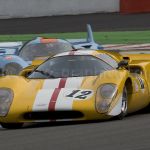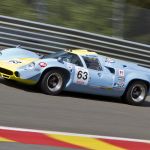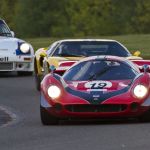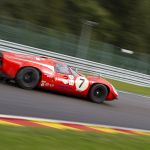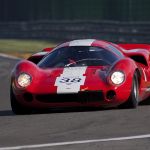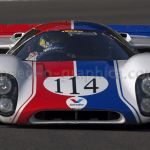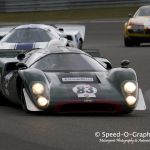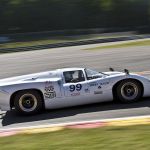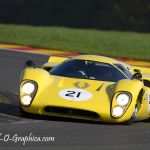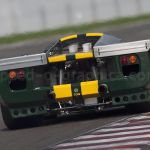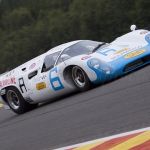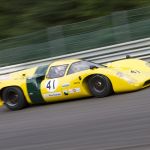Immortal designs of the sixties: Lola T70

By Marcel Hundscheid/Speed-O-Graphica.com
Sit back, relax and spend a few minutes with the beautiful Lola T70.
Designed way back in the last century, the sleek lines of this immortal sportscar keep attacking historic motorsport fans around the world. In the European historic motorsports scene the car is a real crowd puller and on several occasions more than a dozen fill the starting grids. Check out our report and fetaured gallery.
Designed by Eric Broadley back in 1965 and built in Slough, England, the Lola T70 was up against the almost unbeatable Porsche 917 and Ferrari 512M sports cars.
In its inaugural year, 1966, the car proved to be in a class of its own as it entered the Can-Am championship. Fifty years after the introduction at the 1965 London Racing Car Show, the T70 remains iconic in the history of sportscar racing.
Broadley established Lola Cars back in 1958 and gained success in designing and building single seaters for Formula Junior, Formula 2 and Formula 3. This success led to a contract with Ford on their GT40 project. As Broadley was unhappy with the fact that he couldn’t build cars he desired, he stopped working for Ford and started to create the fastest sportscar of that particular era.

By that time both Ford and Chevrolet offered V8 powerplants. Broadley combined the 500 hp engine with a light, mid-engined design. Together with World Champion John Surtees, Broadley developed the Lola T70 into one of the most successful sportscars from that time.
Lola’s first T70 was presented at the London Racing Car Show in January 1965, using an aluminium tube and steel-chassis, along with a fiberglass body. Seventeen Mk.1s were produced equipped with n 5359 cc/327 cu in Chevrolet V8 engine, creating 400 hp/298.3 kw.
The car made its racing debut at Silverstone driven by John Surtees in pouring rain. As Surtees spun more than he led, it was agreed to fit the T70 with a rear spoiler.

An upgraded version of the initial Lola T70 Mk.I was the Mk.II that appeared in 1966.
The Mk.II was even 32 kg (70 lbs) lighter as Broadley used much more aluminium in the chassis. Most of the 33 chassis built were run with the small block V8 engines. The Mk.II would go into history as Lola’s most successful T70. Denny Hulme scored 11 victories in Europe, in the USA the T70 Mk.II won the USSRC championship in both 1966 and 1967. John Surtees won the 1966 Can-Am Championship, winning 3 out of 6 races.

The Mk.II used wider wheels, consolidated radiators including a large cooling unit in the nose as well as revised suspension points. Besides the use of much more aluminium, Broadley used riveting, instead of welding, to shed further weight.
In the end Broadley managed to reduce to overall weight just a little more than 100 pounds. The T70 Mk.II would prove to be one of the most successful sports cars in history.

The Mk.II was entered in the newly formed CanAm series. The car dominated nearly every race it entered, scoring five wins in six rounds. Lola’s success came to a halt in 1967 as McLaren entered the CanAm series and would dominate the championship. A T70 would claim just a single victory in that particular year.

Lola introduced the T70 Mk.III Coupé featuring more horsepower and improved performance. Initially Lola used a 327 small-block Chevrolet engine, followed by an upgraded 350 Chevrolet engine. The straight back end of this version gave the car the nickname of ‘breadvan’, resembling delivery trucks from the particular era.

Tony Southgate designed the new sleek body of the Mk.III, made to follow Group 4 regulations. In Le Mans, the T70 Mk.III could reach top speeds of 200 mph on the Mulsanne straight. The new T70 Mk.III Coupe was a very aerodynamic car, created by using a wind-tunnel. Thanks to its high tail the car produced considerable downforce. After the installation of a roof and a windscreen, the car was eligible for Group 4.

Sad to say but the Mk.III Coupé wasn’t much of a success. It appeared backed by the Lola factory at Le Mans, driven by John Surtees and David Hobbs. In the end, the car lasted only 25 laps, powered by an Aston Martin V8.

A slightly updated version was the Mk.IIIB introduced back in 1969.
The car featured a ‘squared off’ bodywork, was equipped with bigger brakes and used a 5 speed Hewland 600LG gearbox. Besides this the Mk.IIIB variant used a full aluminium monocoque.
The 4.995 cc Chevrolet V8 was equipped with fuel injection and produced about 450 hp. The Mk.IIB could easily be recognized by the lower nose, equipped with two headlights on either side. Back in 2005 Lola Cars announced an authentic and limited continuation series of the original T70 Mk.IIIB.
© Marcel Hundscheid/Speed-O-Graphica.com

